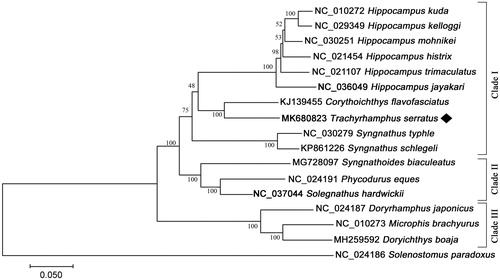Abstract
In this study, the complete mitochondrial sequence of the crested pipefish, Trachyrhamphus serratus (T. serratus) has been amplified and sequenced. The mtDNA of T. serratus was a circular molecule of 16,597 bp in length with 13 protein-coding genes (PCGs), 2 rRNA genes, 22 tRNA genes, and a control region. The lengths of 12S and 16S rRNA were 936 bp and 1863 bp, respectively. Phylogenetic analysis indicated that T. serratus clustered together with Corythoichthys flavofasciatus, suggesting a close relationship between the two genera. This was the first record of the complete mitochondrial genome from the genus Trachyrhamphus, which will be useful for the elucidation of evolution and conservation strategy in Syngnathidae family.
The crested pipefish Trachyrhamphus serratus is a widespread marine pipefish that ranges from southern India and Sri Lanka to Japan and South Korea (Dawson Citation1985). Trachyrhamphus serratus generally inhabits sandy mud substrates and algal beds at depths of 15–100 m, which is used extensively for the treatment of impotence and tumor in China (Kuiter Citation2000; Wang et al. Citation2011). Due to the morphological similarities between T. serratus and other Syngnathidae species, it was often traded as adulteration of traditional Chinese medicinal pipefish (Gao et al. Citation2018). Although the appearance between T. serratus and other medicinal pipefish is similar, their medicinal efficacy differs considerably (Hu and Li Citation2002). The complete mitochondrial genome of T. serratus would provide basic molecular data for phylogenetic analysis and further development on species identification strategies.
Here, we determined the complete mitochondrial genome of T. serratus and constructed the phylogenetic relationship among the family Syngnathidae. The specimen of T. serratus was purchased from Bozhou Medicinal Herb Market at Anhui Province of China and identified based on its key morphological characteristics, including extremely short snout, superior trunk, and discontinuous tail ridges (Zhang et al. Citation1997). The sample of T. serratus LM-22 was deposited at the collection center of Zhejiang Chinese Medical University. Total genomic DNA was extracted from the tail muscle and the complete mtDNA of T. serratus was determined according to our previous reports (Fang et al. Citation2018; Zhu et al. Citation2018; Lai et al. Citation2019). The mitochondrial genome sequence of T. serratus was deposited into GenBank under the accession number MK680823.
The mtDNA of T. serratus was a circular molecule of 16,597 bp in length with 13 protein-coding genes (PCGs), 2 rRNA genes, 22 tRNA genes, and a control region. The overall base composition of T. serratus was 29.56% for A, 28.35% for C, 16.39% for G, and 25.70% for T, respectively. Similar to the most vertebral mitochondrial genome, nucleotide overlaps and space gaps were very common in T. serratus (Cheng et al. Citation2013; Chen et al. Citation2018). There are 8 intergenic spacers region and 11 overlap spacer in T. serratus. The total length of the 13 PCGs was 11,454 bp, which accounts for 67.55% in the whole mitochondrial genome. The lengths of 12S ribosomal RNA and 16S ribosomal RNA were 936 bp and 1863 bp, respectively. The control region locating between tRNA-Pro and tRNA-Phe gene was 1159 bp in length, ranging from 15,799 to 16,957 bp.
The phylogenetic relationships of T. serratus and other Syngnathidae species were inferred utilizing maximum-likelihood (ML) based on the complete mitochondrial sequences (Figure 1). The monophyletic group of Syngnathidae Family was divided into three clades. Clade I includes species from the genus of Hippocampus, Corythoichthys, Trachyrhamphus, and Syngnathus. Trachyrhamphus serratus clustered together with Corythoichthys flavofasciatus with high-statistical support, suggesting a relatively close relationship between the two genera. The complete mitogenome sequence provides basic molecular data of T. serratus, which would be helpful for the understanding of phylogenetic relationships in family Syngnathidae.
Disclosure statement
No potential conflict of interest was reported by the authors.
Figure 1. Maximum-likelihood (ML) phylogenetic tree of Trachyrhamphus serratus and other species in Syngnathidae using Sloenostomus paradoxus as outgroup. Number above each node refers to the bootstrap probability generated from 100 replicates. The GenBank accession number for the complete mitochondrial genome was given before the species name.

Additional information
Funding
References
- Cheng R, Zheng X, Ma Y, Li Q. 2013. The complete mitochondrial genomes of two octopods Cistopus chinensis and Cistopus taiwanicus: revealing the phylogenetic position of the genus Cistopus within the order Octopoda. PLoS One. 8:e84216.
- Chen M, Zhu L, Chen J, Zhang G, Cheng R, Ge Y. 2018. The complete mitochondrial genome of the short snouted seahorse Hippocampus hippocampus, Linnaeus 1758 (Syngnathiformes: Syngnathidae) and its phylogenetic implications. Conservation Genet Resour. 10:783–787.
- Dawson CE. 1985. Indo-Pacific Pipefishes (Red Sea to the Americas). Ocean Springs (USA): Gulf Coast Research Laboratory.
- Fang Y, Zhu L, Chen M, Ge Y, Zhang G, Cheng R. 2018. Characterization of the complete mitochondrial genome of the medical pipefish Doryichthys boaja Bleeker 1850. Mitochondr DNA B. 3:883–885.
- Gao L, Yin Y, Li J, Yuan Y, Jiang C, Gao W, Zhang X, Huang L. 2018. Identification of traditional Chinese medicinal pipefish and exclusion of common adulterants by multiplex PCR based on 12S sequences of specific alleles. Mitochondr DNA A DNA Mapp Seq Anal. 29:340–346.
- Hu JY, Li BF. 2002. Research on anti-fatigue effect of Syngnathus acus L. Chin J Mar Drugs. 21:48–53.
- Kuiter RH. 2000. Seahorses, Pipefishes and their relatives: a comprehensive guide to Syngnathiformes. Chorleywood (UK): TMC Publishing.
- Lai M, Sun S, Chen J, Lou Z, Qiu F, Zhang G, Cheng R. 2019. Complete mitochondrial genome sequence for the seahorse adulteration Hippocampus camelopardalis Bianconi 1854. Mitochondr DNA B. 4:432–433.
- Wang M, He Y, Nie Y, Li X. 2011. Chemical constituents from the antitumor fraction of Trachyrhamphus serratus. Chem Nat Compd. 47:465–466.
- Zhang Z, Xu G, Xu L, Wang Q, Li J. 1997. The morphological and commercial identification on medicinal materials "hailong". Zhong Yao Cai. 20:63–66.
- Zhu L, Chen M, Cheng R, Ge W, Zhang G, Ge Y. 2018. Complete mitochondrial genome characterization of the alligator pipefish Syngnathoides biaculeatus and phylogenetic analysis of family Syngnathidae. Conserv Genet Resour. DOI:10.1007/s12686-018-1032-1.
